MercoPress. South Atlantic News Agency
Antarctic ozone hole in 2012, the second smallest in the last 20 years, says NASA
 NASA images of the ozone hole over Antarctica
NASA images of the ozone hole over Antarctica The average area covered by the Antarctic ozone hole this year was the second smallest in the last 20 years, according to data from NASA and National Oceanic and Atmospheric Administration (NOAA) satellites. Scientists attribute the change to warmer temperatures in the Antarctic lower stratosphere.
The ozone hole reached its maximum size Sept. 22, covering 8.2 million square miles (21.2 million square kilometres), or the area of the United States, Canada and Mexico combined. The average size of the 2012 ozone hole was 6.9 million square miles (17.9 million square kilometres). The Sept. 6, 2000 ozone hole was the largest on record at 11.5 million square miles (29.9 million square kilometres).
“The ozone hole mainly is caused by chlorine from human-produced chemicals, and these chlorine levels are still sizable in the Antarctic stratosphere,” said NASA atmospheric scientist Paul Newman of NASA's Goddard Space Flight Centre in Greenbelt, Md. “Natural fluctuations in weather patterns resulted in warmer stratospheric temperatures this year. These temperatures led to a smaller ozone hole.”
The ozone layer acts as Earth's natural shield against ultraviolet radiation, which can cause skin cancer. The ozone hole phenomenon began making a yearly appearance in the early 1980s. The Antarctic ozone layer likely will not return to its early 1980s state until about 2065, Newman said. The lengthy recovery is because of the long lifetimes of ozone-depleting substances in the atmosphere. Overall atmospheric ozone no longer is declining as concentrations of ozone-depleting substances decrease. The decrease is the result of an international agreement regulating the production of certain chemicals.
This year also marked a change in the concentration of ozone over the Antarctic. The minimum value of total ozone in the ozone hole was the second highest level in two decades. Total ozone, measured in Dobson Units (DU) reached 124 DU on Oct. 1. NOAA ground-based measurements at the South Pole recorded 136 DU on Oct. 5. When the ozone hole is not present, total ozone typically ranges from 240-500 DU.
This is the first year growth of the ozone hole has been observed by an ozone-monitoring instrument on the Suomi National Polar-orbiting Partnership (NPP) satellite. The instrument, called the Ozone Mapping Profiler Suite (OMPS), is based on previous instruments, such as the Total Ozone Mapping Spectrometer (TOMS) and the Solar Backscatter Ultraviolet instrument (SBUV/2). OMPS continues a satellite record dating back to the early 1970s.
In addition to observing the annual formation and extent of the ozone hole, scientists hope OMPS will help them better understand ozone destruction in the middle and upper stratosphere with its Nadir Profiler. Ozone variations in the lower stratosphere will be measured with its Limb Profiler.
“OMPS Limb looks sideways, and it can measure ozone as a function of height,” said Pawan K. Bhartia, a NASA atmospheric physicist and OMPS Limb instrument lead. “This OMPS instrument allows us to more closely see the vertical development of Antarctic ozone depletion in the lower stratosphere where the ozone hole occurs.”
NASA and NOAA have been monitoring the ozone layer on the ground and with a variety of instruments on satellites and balloons since the 1970s. Long-term ozone monitoring instruments have included TOMS, SBUV/2, Stratospheric Aerosol and Gas Experiment series of instruments, the Microwave Limb Sounder, the Ozone Monitoring Instrument, and the OMPS instrument on Suomi NPP. Suomi NPP is a bridging mission leading to the next-generation polar-orbiting environmental satellites called the Joint Polar Satellite System, will extend ozone monitoring into the 2030s.

![“Working directly with President [Donald] Trump and Congress, we accomplished what no one else could,” Patel stressed](/data/cache/noticias/108417/130x80/fbi.jpg)


Top Comments
Disclaimer & comment rules-

-

-

Read all commentssurprised with all the hot air coming from cfk
Oct 26th, 2012 - 06:47 am 0“The ozone hole mainly is caused by chlorine from human-produced chemicals, and these chlorine levels are still sizable in the Antarctic stratosphere,” said NASA atmospheric scientist Paul Newman“
Oct 26th, 2012 - 08:57 am 0There is no empirical basis for that statement, it was shown in a lab that CFC's can attack ozone and then it was extrapolated to the Antarctic.
”The ozone hole phenomenon began making a yearly appearance in the early 1980s.” False, the phenomenon of a thinning of the ozone layer over Antarctica was first identified in 1956. It is a cyclical event and as shown, is temperature dependant. There are also significant levels of CFC's from natural sources, such as underground volcanos and marine plants and animals, eg sponges. These are never acknowledged and it is claimed that CFC's are man made only.
In the spring of 1958 at the French Antarctic Observatory at Dumont d'Urville, Rigaud and Leroy [quoted in Annales Geophysicae (November, 1990)] reported atmospheric ozone levels as low as 110 DU.
In 2009/10 BAS reported:
“Ozone values dropped, to reach a minimum of around 125 DU (60% depletion) in late September, (Antarctic spring). The lowest daily value measured was 107 DU on October 1. This minimum value is similar to those recorded each October since the early 1990s.”
#2 So we should extrapolate from that we shouldn't make the same “mistake” of taking action with climate change as we did with the ozone? Meanwhile theres a tropical storm in Manhattan!
Oct 30th, 2012 - 02:10 pm 0Commenting for this story is now closed.
If you have a Facebook account, become a fan and comment on our Facebook Page!